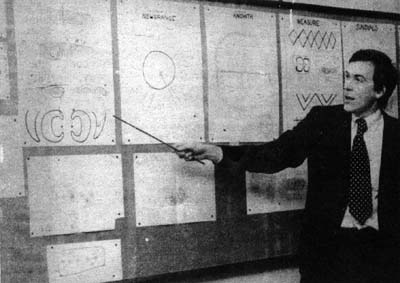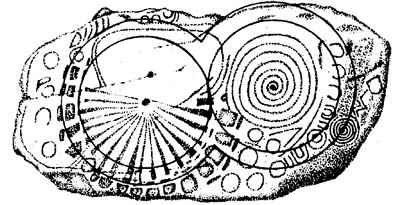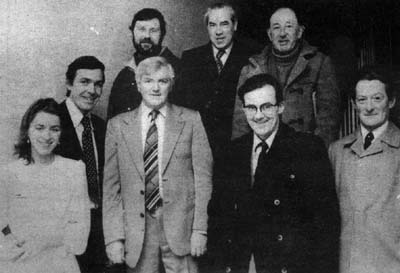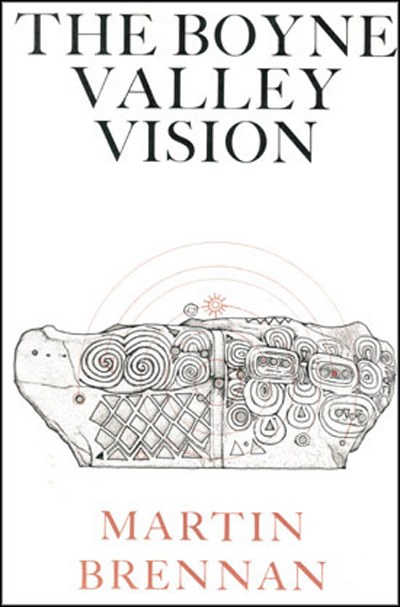Ireland was at the centre of Megalithic Civilisation

Martin Brennan explaining how he interpreted the inscriptions in stone found on the Boyne Valley megaliths
A young Irish-American, Martin Brennan, who claims to have made astonishing discoveries about some of the best known ancient sites in the Midlands during the past year, spoke for the first time about his findings in Mullingar on Thursday 7th February 1980, when he lectured to members of the local Archaeological and Historical Society.
Upwards of one hundred and fifty people attended the lecture, held in St. Mary's College, Mullingar, and were impressed with the well documented arguments advanced by Mr. Brennan, a graphic designer in Dublin, who has studied the Boyne Valley inscriptions for ten years.
Briefly put, the lecturer contends that he has discovered a highly sophisticated and advanced technology, a Stone Age science, in ancient Ireland, which no one has hitherto guessed at, and he puts Newgrange, the best known of the Boyne Valley mounds at the centre of megalithic civilisation.
In the Mullingar lecture, Mr. Brennan said that it was a combination of visual communication, seeking to interpret the strange signs and symbols in stone, and archeo-astronomy, which led to the decoding of Newgrange. Since the initial discoveries, about eleven months ago, many additional discoveries, some highly important, had been made.
And he said that what had been found out so far was "only the tip of the iceberg", as he feels that when more intensive investigations take place, a great deal more will be learned about the ancient people who left their monuments in the Boyne Valley, at Loughcrew, (near Oldcastle) and elsewhere. Full investigations would lead to a proper understanding of what had happened in the past, and to a better understanding of the origins of civilisation.
The lecturer described how the original discoveries were made in the Boyne Valley, with the aid of drawings, and measurements taken from the Stone Age markings, he explained how the inscriptions form a system of inter communication which is "ordered, logical and meaningful" and said this system can now be understood.
He gave details of the system of measurement in use on the stones at Newgrange, Knowth, Loughcrew and elsewhere and described how the measurements are clearly and explicitly stated, and how they are geometrically related.
Oldest Sundials in the World?
He explained how it had been found that intensive sundialling was practiced, with dialling techniques which were scientific in nature and highly advanced and said the dials had been recognised, and gave data on how the Newgrange people divided the day."These are the oldest sundials in the world and predate all others by thousands of years," he said. He gave details of how lunar theory had been developed by the Boyne Valley people, and said they were not just a people who understood the sun and how it functioned, but that they also understood and had a completely developed lunar theory.
World's Oldest Calendar
Mr. Brennan said the inscriptions included a calendar which is of extreme importance. It was a unique calendar, and was the oldest in the world. It was also a computer, the oldest computational device in the world and was a very intricate one.Considerable advances had also been made in geometry and there was serious astronomy, far removed from stargazing, also involved, he said. One of the most controversial points arising form the discoveries claimed to have been made by Mr. Brennan, is in regard to the function of the ancient mounds, which are thought to date back to 3,000 B.C. or thereabouts. It has always been accepted that Newgrange, Knowth, and all the chambered mounds at Loughcrew and elsewhere, were built as places of burial. Martin Brennan rejects this "fact" and claims that their primary purpose was as astronomical observatories. He described during the lecture how the twelve stones of the "great circle" around the Newgrange mound are all situated in astronomically important positions. The stones marked Summer Solstice, sunrise and sunset, Winter Solstice, sunrise and sunset. "The chances that twelve stones could just happen to fall in these positions, or be accidentally placed in astronomical order, are zero," he said. They had consciously laid out the stones.
Mr. Brennan said that as a result of discovering of Newgrange, that they were dealing with a people who understood north and south, and had the meridian marked; he decided to do an intensive visual analysis of the markings, commencing on St. Patrick's Day last year. After three weeks, he had isolated markings called "offsets" and when he checked at Dowth, beside where he lived, he found that the "offset" was what it seemed to be, a segmented line, giving measurements. This discovery led to others, and it was realised that the designers of the markings in the Boyne Valley had given their measuring system, marking it in stone. Their measurements were there, to be checked, on the stones.

The circle on the left, on this Knowth stone, is a sundial, with the design constructed on a measured geometric grid, says Martin Brennan. Based on a segmented arc, it is recognised as an advanced form of sundialling
The Oldest
Further checking had revealed that geometric principles were involved. Four stones, from Newgrange and Dowth, when analysed, proved to have a geometrical grid. Reflective symmetry was in use, but such advanced concepts of geometry were not supposed to have emerged until Egyptians times. He said that the Boyne Valley people had obtained this knowledge from sundialling. The first archaeological remains of a sundial was in Egypt, dating from 1200BC. But the dials found at Knowth represented an advanced stage of sundialling. The planetary hours were given and the dialler could define an eight-hour day, long in summer, short in winter. Such sundials were used up to medieval times.What we have in the Boyne Valley not only predates Egyptian dials, but they've taken sundialling to an extreme". The lecturer said. One of the clues to an understanding of these people is that sundialling was one of their main tools. They made horizontal dials, vertical dials, and put dials everywhere, he said.
Basically, what the inscriptions represent are the ideas of a symmetrical universe, as discovered by our Stone Age ancestors.
Moon Dialling
Moon dialling is a progression of sun-dialling. The Boyne Valley people understood a great deal about the movements of the moon, and began to gain empirical information which is the beginnings of civilisation. Not alone does the sun shine down the Newgrange passage at Winter Solstice, but every 19 years, the moon shines down the passage, marking a different cycle of time, Mr Brennan claimed. The Boyne Valley people were studying time and space. To reach the understanding that the moon would shine down the Newgrange passage every 19 years took centuries of observation and analysis, he said. They had figured out its cycle. "Nobody has yet seen the moon shine down the passage, but it is going to happen," he asserted.The Greeks in writing about their travels, told about the Hyperboreans who have not been identified, who had a spherical temple, and into it, the moon came every 19 years. People had interpreted this as referring to Stone-henge, but that the sanctuary referred to was Newgrange. Newgrange's main purpose was as a lunar device, he said.
At Knowth, with the entrance stones to the passages aligned East and West, it was not being speculative to say that the Knowth chambers too, were scientific devices. What probably occurs at Knowth, and he hopes to be able to prove it, is that the rising Equinox sun enters the Knowth chamber and the setting Equinox sun enters the other chamber.
Every nineteen years, when the moon was on the same node as the sun, as the rising sun entered one chamber. Also, once every nineteen years, the setting sun would be shining into one chamber as the full moon rising shone into the other chamber.
This to me is the most extraordinary thing that happens in the Boyne Valley, Mr Brennan said. Newgrange was built in order to get the nineteen year cycle of the moon, he said. Early peoples, like the Babylonians and Egyptians had also concentrated on astronomy, and the early people in North West Europe had done the same thing. Astronomy was their major study.
Calendar Stone
The lecturer went into detail to describe an intricate calendar stone on the south west side of Knowth. This showed, visually, the phases of the moon from one the 29 days, and they allowed for a 30 day month, when this was necessary. They didn't need to know how to count to follow the calendar. It was a one-to-one visual comparison. The Boyne Valley calendar was very explicit and precise.Mr. Brennan said that in the Boyne Valley, the mounds and inscriptions worked together. The mounds were an extension of the inscriptions, with one verifying the other. The calendar worked perfectly for 31 months.
Celtic Calendar
An old Celtic calendar, the Coligny Calendar, dating from about 100 AD or 100 BC, made of bronze, was recognised as a scientific calendar, using a 31-month period. A 31-month calendar, incorporation solar and lunar movements, was a very good calendar, in which an extra month was included every two and a half years.The Boyne Valley calendar worked ingeniously and predated the Coligny calendar by thousands of years. The American, Leask who fully investigated the Coligny calendar, concluded that was an earlier calendar somewhere, a lunar-solar calendar.
"This calendar here is the one, the prototype," Mr. Brennan said.
For a people living in this early period, being able to see, visually exactly where they were, in time, was a great source of security, a tremendous leap forward. They knew exactly where they were on a time scale, and could define time precisely. The 19-year moon cycle was supposed to be invented by a Greek, Meton about 400 BC. But here in the Boyne Valley, was a metonic cycle thousands of years earlier.
Logical
It was logical to think that these early people, should be anxious to understand all these things. These were able to solve the main problems of human organisation facing them, so it is not unusual to think of these inscriptions and of mounds built to solve these problems, to assist agriculture, determine time, and so on.Mr. Brennan said that the investigation also proved that the Boyne Valley people understood about celestial times, something which the Greeks are supposed to have worked out, thousands of years later. It was interesting to discover that the Greeks had described obtaining this information from foreigners, and it was possible the astronomical ideas which the Greeks had, came from the early Celts.
The lecturer said that they had also found, from checking the Boyne Valley mounds, that another system of measurement was in use, over much larger distances. The distance from Newgrange to Loughcrew, about 33 miles, appeared to have been used as a unit measuring the distance between Newgrange and similar mounds over vast distances around Ireland. Accomplishing such feats entailed a knowledge of latitude and longitude and he felt this had been achieved by sundialling.
Time Capsule
The Boyne Valley men, or women, had not only made a deliberate and conscious effort to record astronomical knowledge, but had built huge monuments capable of transmitting this knowledge to a culture thousands of years into the future. Their achievement had been preserved in a kind of time capsule."Newgrange is the oldest scientific instrument in the world still functioning. It predates Stonehenge and the Pyramids, and stands as one of the world's most ancient monuments. It is quite likely it will still be functioning when our own scientific instruments have turned to dust", he said.
There was no way in which the findings in the Boyne Valley could be accommodated into the present accepted model of pre-history, which saw civilisation beginning in the Middle East. Even one of the Knowth sundials could not be accommodated into it.
Asked about the mounds as burial places, he said that it was very difficult to distinguish fact from assumption. It had been assumed they were constructed as graves, but neither in form nor in function did they even remotely resemble graves. Anything could be used as a grave, even astronomical observatories.
The vote of thanks was proposed by the Chairman of the Mullingar Society James N. Daly, and seconded by Leo Daly committed member.

The lecturer, Martin Brennan (second from left) and his wife (on left), pictured with some of the committee members of Mullingar Archaeological and Historical Society (left to right front) James N. Daly, Chairman; Dick Hogan, Secretary; Tom Cassidy; (l. to r. behind), Dermot Bannon, John O'Keefe and Leo Daly
The Boyne Valley Vision
 The Boyne Valley Vision
by Martin Brennan. Published by The Dolmen Press in 1980.
The Boyne Valley Vision
by Martin Brennan. Published by The Dolmen Press in 1980.
In this book Martin Brennan presents an entirely new interpretation of these monuments, one which challenges the conclusions of earlier studies and offers conclusive evidence which radically changes our knowledge of megalithic culture in Ireland. The Boyne Valley Vision is a personal step-by-step account of a quest that has resulted in some of the most astounding and profound archaeological decipherments of our time.
Martin Brennan demonstrates in his text and in some ninety drawings and figures from his pen the vision of the universe transmitted by the artists of megalithic Ireland in their designs carved in naked rock. He shows that the ideas expressed by these artists are more substantial than the stones on which they are incised. His study exposes for the first time an entire cosmology, a vocabulary of symbols, the sundials, the calendar and other scientific tools of the oldest culture known to us.
Purchase at Amazon.com or Amazon.co.uk
Boyne Valley Private Day Tour
 Immerse yourself in the rich heritage and culture of the Boyne Valley with our full-day private tours.
Visit Newgrange World Heritage site, explore the Hill of Slane, where Saint Patrick famously lit the Paschal fire.
Discover the Hill of Tara, the ancient seat of power for the High Kings of Ireland.
Book Now
Immerse yourself in the rich heritage and culture of the Boyne Valley with our full-day private tours.
Visit Newgrange World Heritage site, explore the Hill of Slane, where Saint Patrick famously lit the Paschal fire.
Discover the Hill of Tara, the ancient seat of power for the High Kings of Ireland.
Book Now
Home
| Visitor Centre
| Tours
| Winter Solstice
| Solstice Lottery
| Images
| Local Area
| News
| Knowth
| Dowth
| Articles
| Art
| Books
| Directions
| Accommodation
| Contact

